OSD Tessellation shader Interface
Basic
Starting with 3.0, Osd tessellation shaders can be used as a set of functions from client shader code. In order to tessellate Osd patches, client shader code should perform the following steps (regular B-spline patch case):
- In a tessellation control shader
- fetch a PatchParam for the current patch
- call OsdComputePerPatchVertexBSpline() to compute OsdPerPatchVertexBezier.
- compute tessellation level. To prevent cracks on transition patches, two vec4 parameters (tessOuterHi, tessOuterLo) will be needed in addition to built-in gl_TessLevelInner/Outers.
- In a tessellation evaluation shader
- call OsdGetTessParameterization() to remap gl_TessCoord to a patch parameter at which to evaluate.
- call OsdEvalPatchBezier()/OsdEvalPatchGregory() to evaluate the current patch.
The following is a minimal example of GLSL code explaining how client shader code uses OpenSubdiv shader functions to tessellate patches of a patch table.
Tessellation Control Shader Example (for B-Spline patches)
layout (vertices = 16) out; in vec3 position[]; patch out vec4 tessOuterLo, tessOuterHi; out OsdPerPatchVertexBezier v; void main() { // Get a patch param from texture buffer. ivec3 patchParam = OsdGetPatchParam(gl_PrimitiveID); // Compute per-patch vertices. OsdComputePerPatchVertexBSpline(patchParam, gl_InvocationID, position, v); // Compute tessellation factors. if (gl_InvocationID == 0) { vec4 tessLevelOuter = vec4(0); vec2 tessLevelInner = vec2(0); OsdGetTessLevelsUniform(patchParam, tessLevelOuter, tessLevelInner, tessOuterLo, tessOuterHi); gl_TessLevelOuter[0] = tessLevelOuter[0]; gl_TessLevelOuter[1] = tessLevelOuter[1]; gl_TessLevelOuter[2] = tessLevelOuter[2]; gl_TessLevelOuter[3] = tessLevelOuter[3]; gl_TessLevelInner[0] = tessLevelInner[0]; gl_TessLevelInner[1] = tessLevelInner[1]; } }
Tessellation Evaluation Shader Example (for B-Spline patches)
layout(quads) in; patch in vec4 tessOuterLo, tessOuterHi; in OsdPerPatchVertexBezier v[]; uniform mat4 mvpMatrix; void main() { // Compute tesscoord. vec2 UV = OsdGetTessParameterization(gl_TessCoord.xy, tessOuterLo, tessOuterHi); vec3 P = vec3(0), dPu = vec3(0), dPv = vec3(0); vec3 N = vec3(0), dNu = vec3(0), dNv = vec3(0); ivec3 patchParam = inpt[0].v.patchParam; // Evaluate patch at the tess coord UV OsdEvalPatchBezier(patchParam, UV, v, P, dPu, dPv, N, dNu, dNv); // Apply model-view-projection matrix. gl_Position = mvpMatrix * vec4(P, 1); }
Basis Conversion
B-spline Patch
The following diagram shows how the Osd shaders process b-spline patches.
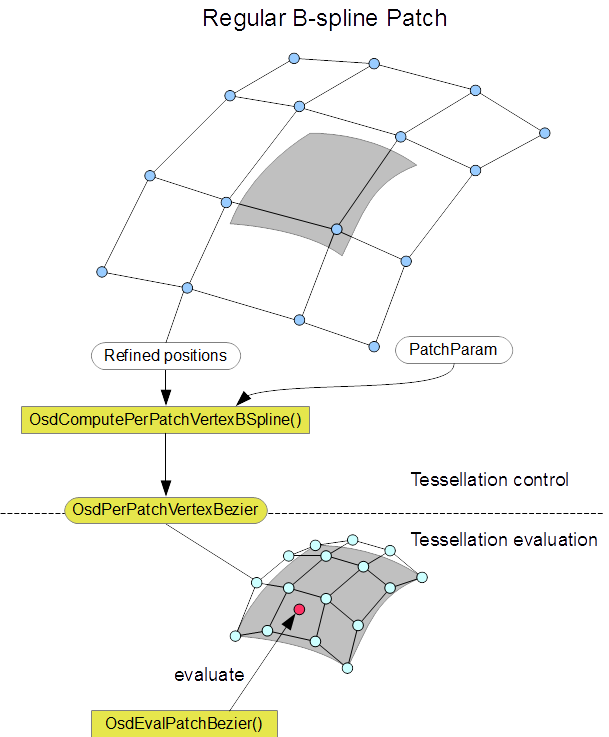
While regular patches are expressed as b-spline patches in Far::PatchTable, the Osd shader converts them into Bezier basis patches for simplicity and efficiency. This conversion is performed in the tessellation control stage. The boundary edge evaluation and single crease matrix evaluation are also resolved during this conversion. OsdComputePerPatchVertexBSpline() can be used for this process. The resulting Bezier control vertices are stored in OsdPerPatchVertexBezier struct.
void OsdComputePerPatchVertexBSpline( ivec3 patchParam, int ID, vec3 cv[16], out OsdPerPatchVertexBezier result);
The tessellation evaluation shader takes an array of OsdPerPatchVertexBezier struct, and then evaluates the patch using the OsdEvalPatchBezier() function.
void OsdEvalPatchBezier(ivec3 patchParam, vec2 UV, OsdPerPatchVertexBezier cv[16], out vec3 P, out vec3 dPu, out vec3 dPv, out vec3 N, out vec3 dNu, out vec3 dNv)
Gregory Basis Patch
In a similar way, Gregory basis patches are processed as follows:
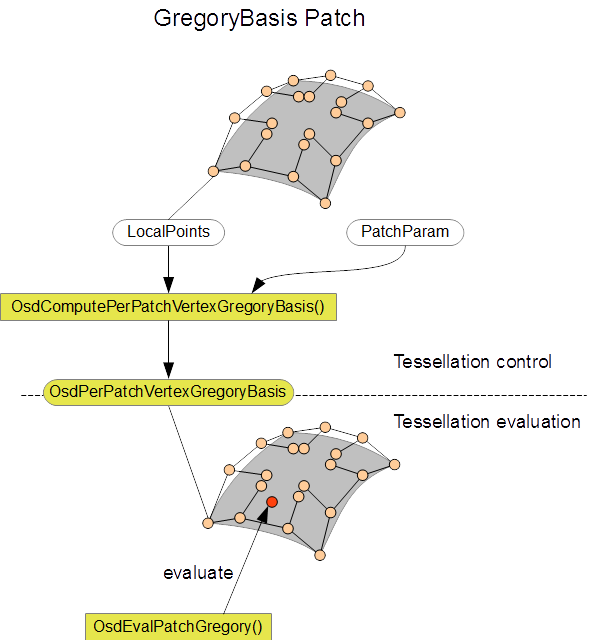
OsdComputePerPatchVertexGregoryBasis() can be used for the Gregory patches (although no basis conversion involved for the Gregory patches) and the resulting vertices are stored in a OsdPerPatchVertexGreogryBasis struct.
void OsdComputePerPatchVertexGregoryBasis( ivec3 patchParam, int ID, vec3 cv, out OsdPerPatchVertexGregoryBasis result)
The tessellation evaluation shader takes an array of OsdPerPatchVertexGregoryBasis struct, and then evaluates the patch using the OsdEvalPatchGregory() function.
void OsdEvalPatchGregory(ivec3 patchParam, vec2 UV, vec3 cv[20], out vec3 P, out vec3 dPu, out vec3 dPv, out vec3 N, out vec3 dNu, out vec3 dNv)
Box-spline Triangle Patch
While regular triangle patches are expressed as triangular box-spline patches in Far::PatchTable, the Osd shader converts them into triangular Bezier patches for consistency. This conversion is performed in the tessellation control stage. The boundary edge evaluation is resolved during this conversion. OsdComputePerPatchVertexBoxSplineTriangle() can be used for this process. The resulting Bezier control vertices are stored in OsdPerPatchVertexBezier struct.
void OsdComputePerPatchVertexBoxSplineTriangle( ivec3 patchParam, int ID, vec3 cv[12], out OsdPerPatchVertexBezier result);
The tessellation evaluation shader takes an array of OsdPerPatchVertexBezier struct, and then evaluates the patch using the OsdEvalPatchBezierTriangle() function.
void OsdEvalPatchBezierTriangle(ivec3 patchParam, vec2 UV, OsdPerPatchVertexBezier cv[15], out vec3 P, out vec3 dPu, out vec3 dPv, out vec3 N, out vec3 dNu, out vec3 dNv)
Gregory Triangle Patch
OsdComputePerPatchVertexGregoryBasis() can be used for the quartic triangular Gregory patches (although no basis conversion involved for the Gregory triangle patches) and the resulting vertices are stored in a OsdPerPatchVertexGreogryBasis struct.
void OsdComputePerPatchVertexGregoryBasis( ivec3 patchParam, int ID, vec3 cv, out OsdPerPatchVertexGregoryBasis result)
The tessellation evaluation shader takes an array of OsdPerPatchVertexGregoryBasis struct, and then evaluates the patch using the OsdEvalPatchGregoryTriangle() function.
void OsdEvalPatchGregoryTriangle(ivec3 patchParam, vec2 UV, vec3 cv[18], out vec3 P, out vec3 dPu, out vec3 dPv, out vec3 N, out vec3 dNu, out vec3 dNv)
Legacy Gregory Patch (2.x compatibility)
OpenSubdiv 3.0 also supports 2.x style Gregory patch evaluation (see far_overview). In order to evaluate a legacy Gregory patch, client needs to bind extra buffers and to perform extra steps in the vertex shader as shown in the following diagram:
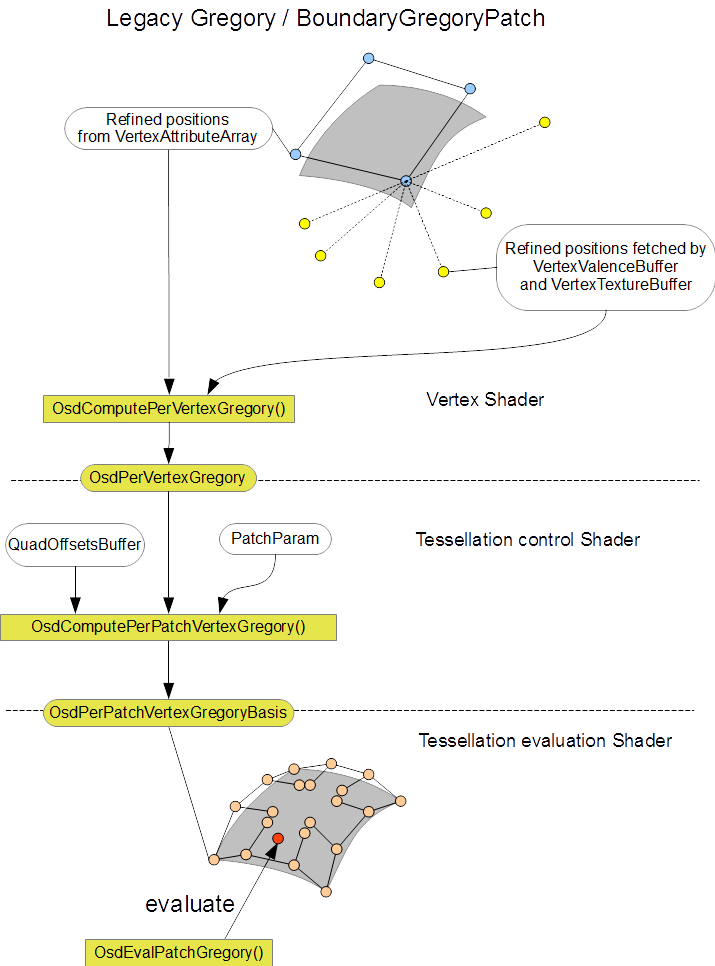
Tessellation levels
Osd provides both uniform and screen-space adaptive tessellation level computation.
Because of the nature of feature adaptive subdivision, we need to pay extra attention for a patch's outer tessellation level for the screen-space adaptive case so that cracks don't appear.
An edge of the patch marked as a transition edge is split into two segments (Hi and Lo).

The Osd shaders uses these two segments to ensure the same tessellation along the edge between different levels of subdivision. In the following example, suppose the left hand side patch has determined the tessellation level of its right edge to be 5. gl_TessLevelOuter is set to 5 for the edge, and at the same time we also pass 2 and 3 to the tessellation evaluation shader as separate levels for the two segments of the edge split at the middle.
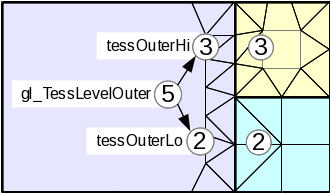
Tessellation levels at each tessellated vertex
The tessellation evaluation shader takes gl_TessCoord and those two values, and remaps gl_TessCoord using OsdGetTessParameterization() or OsdGetTessLevelParameterizationTriangle() to ensure the parameters are consistent across adjacent patches.
vec2 OsdGetTessParameterization(vec2 uv, vec4 tessOuterLo, vec4 tessOuterHi);
vec2 OsdGetTessParameterizationTriangle(vec3 uvw, vec4 tessOuterLo, vec4 tessOuterHi);
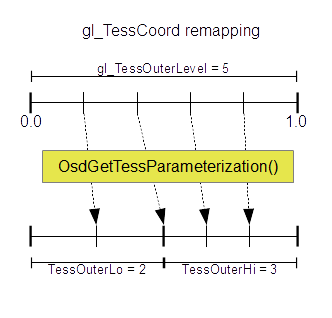
Tessellation levels computed at each patch
These tessellation levels can be computed the corresponding method in the tesselation control shader. Note that these functions potentially requires all bezier control points, you need to call barrier() to ensure the conversion is done for all invocations. See osd/glslPatchBSpline.glsl for more details.
Uniform
void OsdGetTessLevelsUniform(ivec3 patchParam, out vec4 tessLevelOuter, out vec2 tessLevelInner, out vec4 tessOuterLo, out vec4 tessOuterHi)
void OsdGetTessLevelsUniformTriangle(ivec3 patchParam, out vec4 tessLevelOuter, out vec2 tessLevelInner, out vec4 tessOuterLo, out vec4 tessOuterHi)
Screenspace
void OsdEvalPatchBezierTessLevels( OsdPerPatchVertexBezier cpBezier[16], ivec3 patchParam, out vec4 tessLevelOuter, out vec2 tessLevelInner, out vec4 tessOuterLo, out vec4 tessOuterHi);
void OsdEvalPatchBezierTriangleTessLevels( vec3 cv[15], ivec3 patchParam, out vec4 tessLevelOuter, out vec2 tessLevelInner, out vec4 tessOuterLo, out vec4 tessOuterHi);
